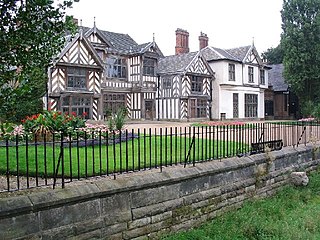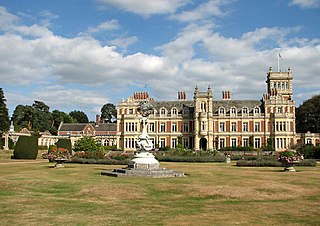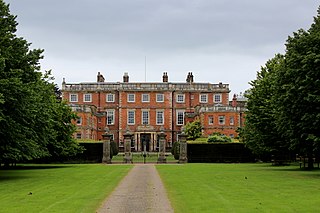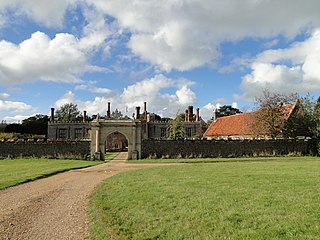
Wythenshawe Hall is a 16th-century timber-framed historic house and former manor house in Wythenshawe, Manchester, England, five miles (8 km) south of Manchester city centre in Wythenshawe Park. Built for Robert Tatton, it was home to the Tatton family for almost 400 years. Its basic plan is a central hall with two projecting wings.

Wimpole Estate is a large estate containing Wimpole Hall, a country house located within the civil parish of Wimpole, Cambridgeshire, England, about 8+1⁄2 miles southwest of Cambridge. The house, begun in 1640, and its 3,000 acres (12 km2) of parkland and farmland are owned by the National Trust. The estate is regularly open to the public and received over 335,000 visitors in 2019. Wimpole is the largest house in Cambridgeshire.

Baconsthorpe Castle, historically known as Baconsthorpe Hall, is a ruined, fortified manor house near the village of Baconsthorpe, Norfolk, England. It was established in the 15th century on the site of a former manor hall, probably by John Heydon I and his father, William. John was an ambitious lawyer with many enemies and built a tall, fortified house, but his descendants became wealthy sheep farmers, and being less worried about attack, developed the property into a more elegant, courtyard house, complete with a nearby deer park.

Weston Park is a country house in Weston-under-Lizard, Staffordshire, England, set in more than 1,000 acres (400 ha) of park landscaped by Capability Brown. The park is located 10 miles (16 km) north-west of Wolverhampton, and 8 miles (13 km) east of Telford, close to the border with Shropshire. The 17th-century Hall is a Grade I listed building and several other features of the estate, such as the Orangery and the Stable block, are separately listed as Grade II.

Somerleyton Hall is a country house and 5,000-acre (2,000 ha) estate near Somerleyton and Lowestoft in Suffolk, England owned and lived in by Hugh Crossley, 4th Baron Somerleyton, originally designed by John Thomas. The hall is Grade II* listed on the National Heritage List for England, and its landscaped park and formal gardens are also Grade II* listed on the Register of Historic Parks and Gardens. The formal gardens cover 12 acres (4.9 ha). Inspired by Knepp Wildland, Somerleyton is rewilding 1,000 acres (400 ha) of the estate to which he has introduced free-roaming cattle, large black pigs and Exmoor ponies.

Salthouse is a village and a civil parish in the English county of Norfolk. It is situated on the salt marshes of North Norfolk. It is 3.8 miles (6.1 km) north of Holt, 5.4 miles (8.7 km) west of Sheringham and 26.3 miles (42.3 km) north of Norwich. The village is on the A149 coast road between King's Lynn and Great Yarmouth. The nearest railway station is at Sheringham for the Bittern Line which runs between Sheringham, Cromer and Norwich. The nearest airport is Norwich International Airport. The landscape around Salthouse lies within the Norfolk Coast AONB and the North Norfolk Heritage Coast. The civil parish has an area of 6.22 km2 (2.40 sq mi) and in 2001 had a population of 196 in 88 households, the population increasing to 201 at the 2011 Census. For the purposes of local government, the parish falls within the district of North Norfolk.

Bylaugh is a civil parish in Norfolk, England 4.5 miles (7.2 km) north-east of East Dereham and 13.5 miles (21.7 km) WNW of Norwich. For the purposes of local government it falls within the Upper Wensum Ward of Breckland District Council and the Elmham and Mattishall Division of Norfolk County Council. According to the 2001 census it had a population of 65. At the 2011 census the population remained less than 100 and was included in the civil parish of Sparham.

Helmingham Hall is a moated manor house in Helmingham, Suffolk, England. It was begun by John Tollemache in 1480 and has been owned by the Tollemache family ever since. The house is built around a courtyard in typical late medieval/Tudor style. The house is listed Grade I on the National Heritage List for England, and its park and formal gardens are also Grade I listed on the Register of Historic Parks and Gardens.

Saxlingham is a village and former civil parish, now in the parish of Field Dalling, in the North Norfolk district, in the county of Norfolk, England. It lies 13 miles (21 km) west of Cromer, 26 miles (42 km) north-west of Norwich, 3.6 miles (5.8 km) west of the town of Holt and 126 miles (203 km) north-east of London. In 1931 the parish had a population of 122.

Newby Hall is a country house beside the River Ure in the parish of Skelton-on-Ure in North Yorkshire, England. It is 3 miles (4.8 km) south-east of Ripon and 6 miles (9.7 km) south of Topcliffe Castle, by which the manor of Newby was originally held. A Grade I listed building, the hall contains a collection of furniture and paintings and is surrounded by extensive gardens. Newby Hall is open to the public.

Melton Constable Hall is a large country house in the parish of Melton Constable, Norfolk, England designed in the Christopher Wren style and built between 1664 and 1670 for the Astley family who owned the estate from 1235 until 1948. The core of the house is Elizabethan.

Oulton is a village and civil parish in Norfolk, England. Nearby towns are Reepham and Aylsham. The parish covers an area of 10.58 km2 (4.08 sq mi) and had a population of 196 in 74 households at the 2001 census, reducing slightly to a population of 193 in 81 households at the 2011 census. The village is dispersed with one area of settlement in the vicinity of the church of Saints Peter and Paul, and another area along Oulton Street to the east.

Heydon is a village and civil parish in Norfolk, England.

Ripley Castle is a Grade I listed 14th-century country house in Ripley, North Yorkshire, England, 3 miles (4.8 km) north of Harrogate.
Erasmus Earle was an English lawyer and politician, who became sergeant-at-law to Oliver Cromwell.

Lutton is a village and civil parish in the South Holland district of Lincolnshire, England. The population of the civil parish at the 2011 census was 1,261. It is situated about 4 miles (6 km) north-east from the town of Holbeach. The village has been known by the alternative name of Sutton St Nicholas. The civil parish comprises the village of Lutton, with Lutton Marsh to the north-east and Lutton Garnsgate to the south-west.

Rainthorpe Hall is a Grade I listed Elizabethan country mansion near Tasburgh in Norfolk, England, about 8 miles (13 km) south of Norwich. It is notable for its medieval stonework, wood carvings, rare 17th-century leather wall-coverings and 19th-century Victorian mirrors. The hall's grounds extend to 18.7 acres.
Dunham Massey is a civil parish in the Metropolitan Borough of Trafford, Greater Manchester, England. It contains 48 listed buildings that are recorded in the National Heritage List for England. Of these, three are listed at Grade I, the highest of the three grades, one is at Grade II*, the middle grade, and the others are at Grade II, the lowest grade.

Salle Park is a country house in Norfolk, England, near the village of Salle and about 10 miles (16 km) north-west of Norwich. The house is a Grade II* listed building, and the park and garden are listed Grade II in Historic England's Register of Parks and Gardens.

Hunstanton Hall, Old Hunstanton, Norfolk, England is a country house dating originally from the 15th century. The gatehouse, now detached from the main building, is dated 1487. The wings were built in the seventeenth century and there are Victorian additions. The house was the ancestral home of the L'Estrange family, resident from the time of Domesday until after World War II. During the early 20th century, P. G. Wodehouse, a friend of Charles Le Strange, was a frequent visitor and the hall features in his novel Money for Nothing (1928) and his collection of short stories Very Good, Jeeves (1930). The hall has also been suggested as a model for Blandings Castle. The building suffered two major fires, in 1853 and 1947. In 1948, the hall was sold and converted into apartments. Hunstanton Hall is a Grade I listed building.



















